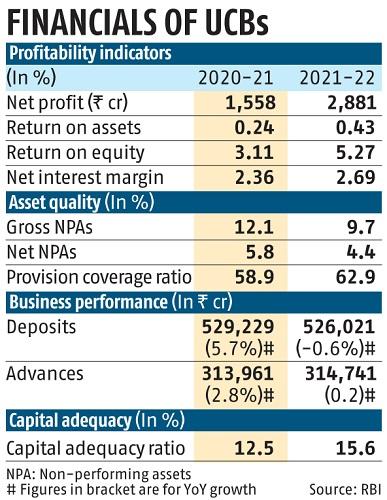Urban Co-op Bank profiles improve on bad loan dip, better profitability
The profile of urban co-operative banks (UCBs) improved in 2021-22 on the back of augmented capital buffers, a decline in bad loans and improved profitability.
However, the growth in deposits and advances took a knock as liabilities shrunk on the back of high base in 2020-21, according to RBI’s Report on Trend and Progress of Banking in India.
The combined net profit of UCBs was up 85 per cent to Rs 2,881 crore in 2021-22. Anaemic credit growth in a low rate regime pulled down their interest income. However, the contraction in interest expenditure was even sharper leading to improvement in their profitability.
Also, the Amalgamation of a large debt-ridden and stressed UCB (Punjab & Maharashtra Coop Bank) with a small finance bank also helped improve profitability.
On the other hand, the increase in non-interest expenditure, especially staff costs, coupled with a sharp reduction in non-interest income, had a moderating influence.

The Asset quality of UCBs, measured by the gross non-performing assets (GNPA) ratio showed improvement for the first time since 2012-13. They had continuously deteriorated during 2015-16 to 2020-21 before improving in 2021-22.
The provisioning requirements have also reduced. UCBs showed prudence and their provision coverage ratio increased year-on-year, although it still remains below that of commercial banks.
RBI report said the deposits contracted during 2021-22 for the first time in nearly two decades, leading to a deceleration in UCBs’ balance sheet. The high deposits base of 2020-21 was a reflection of pandemic-driven precautionary savings, which normalised during 2021-22. On the asset side, loans and advances showed flat growth.
At end-March 2022, about 94 per cent of UCBs maintained capital to risk-weighted assets ratio (CRAR) above the regulatory minimum of nine per cent. Over the last decade, the capital buffers of UCBs have improved, with fewer banks defaulting on regulatory requirements, it added.
 Loan, Personal Loan, Home Loan, Business Loan,Loans in India Loan in India, Personal Loan, Home Loan, Business Loan, Loans in India,Loan Finance,Loan in India, Get Instant Personal Loan,Home Loan, Business Loans in India
Loan, Personal Loan, Home Loan, Business Loan,Loans in India Loan in India, Personal Loan, Home Loan, Business Loan, Loans in India,Loan Finance,Loan in India, Get Instant Personal Loan,Home Loan, Business Loans in India